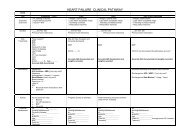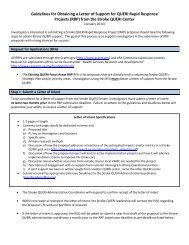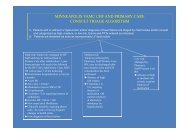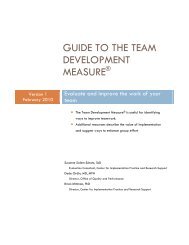The Veteran Supported Education Service Treatment Manual: VetSEd
The Veteran Supported Education Service Treatment Manual: VetSEd
The Veteran Supported Education Service Treatment Manual: VetSEd
You also want an ePaper? Increase the reach of your titles
YUMPU automatically turns print PDFs into web optimized ePapers that Google loves.
<strong>The</strong> role of the <strong>VetSEd</strong> clinical supervisor is to ensure that the peer <strong>VetSEd</strong> provider is<br />
partnering effectively with referred <strong>Veteran</strong>s as they move towards their educational<br />
goals. <strong>The</strong> clinical supervisor fulfills his/her role by tending to the four core elements of<br />
competent <strong>VetSEd</strong> clinical supervision. Each element is discussed in turn below.<br />
C. Core Element #1: <strong>The</strong> Supervisory Alliance<br />
<strong>The</strong> alliance between clinical supervisor and peer <strong>VetSEd</strong> provider is the starting point<br />
for all the work that will occur in supervision. This alliance consists of three essential<br />
components: a) the interpersonal style of the relationship; b) the stage of the relationship;<br />
and c) the supervisory contract (Holloway, 1999). Generally speaking, clinical<br />
supervisors of peer <strong>VetSEd</strong> providers who utilize an empowering and collaborative style,<br />
who tailor their approach to the stage of the supervisory relationship and who develop a<br />
supervisory contract with the peer <strong>VetSEd</strong> provider that specifies the nature and tasks of<br />
supervision will succeed in their supervisory role.<br />
Empowering Collaborative Style<br />
An empowering and collaborative (EC) supervisory style is one that encourages peer<br />
<strong>VetSEd</strong> providers to engage supervision with a sense of curiosity, mutuality and<br />
psychological safety. As a supervisor, you can foster EC by utilizing effective<br />
communication skills such as open-ended questions and reflective listening. In addition,<br />
making space for the peer <strong>VetSEd</strong> provider to articulate personally meaningful goals for<br />
supervision underscores your commitment to EC. See Example 1 for a personally<br />
meaningful goal conversation that includes effective communication. Finally, supervisors<br />
promote EC by attending to diversity issues both within and outside the supervisory<br />
relationship. Diversity issues include not only differences in race, ethnicity, gender,<br />
sexual orientation, age, military status, physical ability, religious/spiritual and mental<br />
health consumer experiences, but also include attention to the power dynamics between<br />
peer <strong>VetSEd</strong> providers and supervisors when discussing these issues. Oftentimes the<br />
person with the least power in a relationship is the least likely to bring up a diversity<br />
concern, for fear that the person with more power might see the issue differently. See<br />
Example 2. For more information about broaching issues of diversity in supervision, see<br />
Ch. 6, Becoming a Multiculturally Competent Supervisor, in Haynes, Corey and Moulton<br />
(2010).<br />
159 | P a g e
















